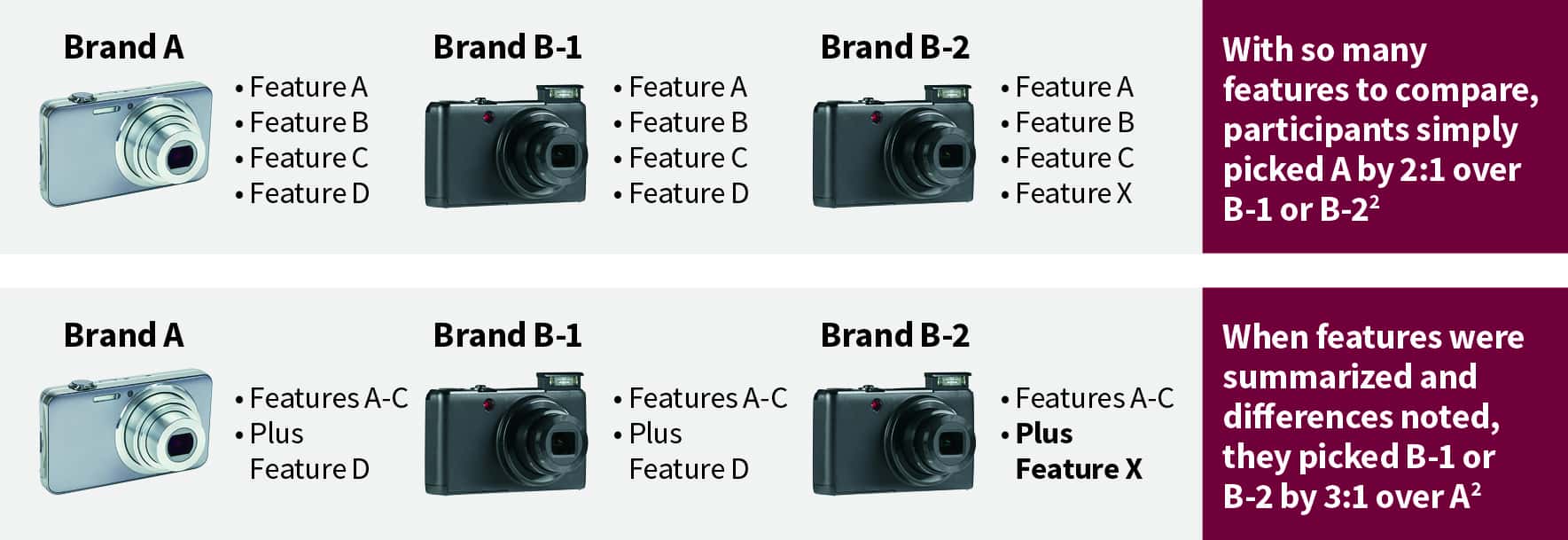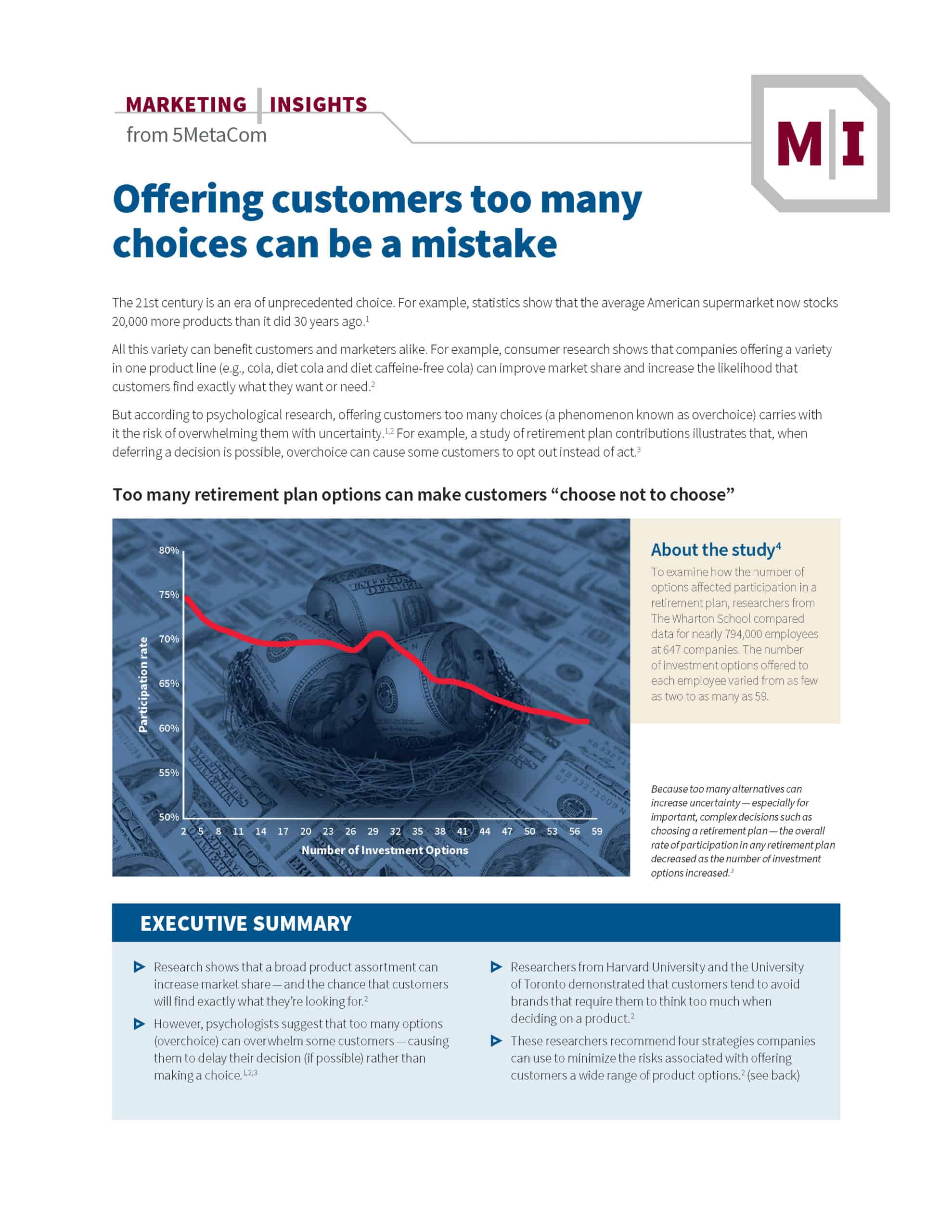Offering customers too many choices can be a mistake
The 21st century is an era of unprecedented choice. For example, statistics show that the average American supermarket now stocks 20,000 more products than it did 30 years ago.1
All this variety can benefit customers and marketers alike. For example, consumer research shows that companies offering a variety in one product line (e.g., cola, diet cola and diet caffeine-free cola) can improve market share and increase the likelihood that customers find exactly what they want or need.2
But according to psychological research, offering customers too many choices (a phenomenon known as overchoice) carries with it the risk of overwhelming them with uncertainty.1,2 For example, a study of retirement plan contributions illustrates that, when deferring a decision is possible, overchoice can cause some customers to opt out instead of act.3
Too many retirement plan options can make customers “choose not to choose”

About the study4
To examine how the number of options affected participation in a retirement plan, researchers from The Wharton School compared data for nearly 794,000 employees at 647 companies. The number of investment options offered to each employee varied from as few as two to as many as 59.
Because too many alternatives can increase uncertainty — especially for important, complex decisions such as choosing a retirement plan — the overall rate of participation in any retirement plan decreased as the number of investment options increased.3
EXECUTIVE SUMMARY
- Research shows that a broad product assortment can increase market share — and the chance that customers will find exactly what they’re looking for.2
- However, psychologists suggest that too many options (overchoice) can overwhelm some customers — causing them to delay their decision (if possible) rather than making a choice.1, 2, 3
- Researchers from Harvard University and the University of Toronto demonstrated that customers tend to avoid brands that require them to think too much when deciding on a product.2
- These researchers recommend four strategies companies can use to minimize the risks associated with offering customers a wide range of product options.2
To overcome overchoice, don’t make customers overthink
Though marketing experts caution that too many choices can be overwhelming or even harmful, surveys consistently demonstrate that customers demand variety.1
So how can you give your customers the options they want without overwhelming them? Marketing professors from Harvard University and the University of Toronto suggest four potential strategies:2
Strategy #1: Bundle discrete features into packaged products
Rather than forcing customers to make tradeoffs among products one feature at a time, combine complementary features to make an overall product comparison more manageable.
One popular technique to simplify comparison is to rank feature packages as good, better and best. For example, Honda once offered DX (good), LX (better) and EX (best) models of its popular Accord sedan. Bundling certain optional features this way can make decision making easier for car buyers.
Strategy #2: Accentuate the differences
When providing information to help customers differentiate between your multiple products, call out the differences and summarize attributes that overlap. This helps customers quickly understand product differences without wading through information that won’t help them make a decision.
Helping customers to decide quickly is especially important when a competing brand has the advantage of offering fewer alternatives — even if you offer only two instead of one.
Focusing only on product differences makes variety more attractive

Strategy #3: Provide a safety net
To help customers feel more comfortable making a purchase decision, minimize the risks they face from choosing unwisely. Researchers discovered that a 30-day exchange policy improved customer preference by 56% for a brand with multiple product options.2
Strategy #4: Limit your product offerings
Sometimes the best way to respond to overchoice is simply to stop offering so many choices.2
As marketing strategists Al and Laura Ries remind us, “The power of a brand is inversely proportional to its scope.”5 So, limiting your product assortment can make your brand a more obvious answer when customers are inundated with multiple choices.

Mango & Passionfruit KitKat® bars? Give me a break!
Starting in 2003, executives at Nestlé SA—the world’s largest food company—conducted an experiment to revive falling candy sales in the U.K. Instead of addressing quality issues that prompted customer complaints, Nestlé began selling its still-popular KitKat bars in new flavors such as Mango & Passionfruit, Blood Orange and Red Berry.
British customers were not amused. The new varieties didn’t just sell poorly—they dragged down the entire brand. For example, some KitKat purists complained that they had trouble finding the original bars on store shelves amid all the new flavors.
During this two-year experiment, annual KitKat sales in the U.K. fell by another 18%. After Nestlé abandoned some of the exotic flavors, KitKat sales rebounded.4
1Grieder, E. (2005). When Choice Consumes: Glut of Shopping Options Can Lead to Dissatisfaction and Regret, Say Researchers. The University of Texas at Austin Office of Public Affairs. Retrieved from http://www.utexas.edu/features/2005/hyperchoice/index.html.
2Gourville, J. & Soman, D. Overchoice and Assortment Type: When and Why Variety Backfires. Marketing Science. Summer 2005;24(3):382-395.
3Iyengar, S., Jiang,W. & Huberman, G. (2004). How Much Choice Is Too Much?: Contributions to 401(k) Retirement Plans. In Pension Design and Structure: New Lessons from Behavioral Finance. O. Mitchell & S. Utkus (Eds.) Oxford, UK: Oxford University Press.
4Ball, D. (2006, July 6). Spoiling the Recipe: Flavor Experiment for KitKat Leaves Nestlé with a Bad Taste. The Wall Street Journal. Retrieved from https://www.wsj.com/articles/SB115215257556699199.
5Ries, A. & Ries, L. (1998). The 22 Immutable Laws of Branding: How to Build a Product or Service into a World-Class Brand. New York: HarperCollins.
